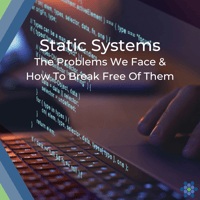Are you worried about sophisticated cyber threats infiltrating your systems through undetected...
Transcript: The Power Behind AI, The Difference Between Artificial Intelligence and Machine Learning?
Daphna: Hello, Thank you for tuning into this FastChat on the Power behind AI.
My name is Daphna Krause. Today I am speaking with Dr. Eugene Santos.
Gene is a Professor of Engineering at Dartmouth.
With almost countless cutting-edge research in topics ranging from Nonlinear decision-making… intelligent systems to our topic of conversation today… artificial intelligence.
Today we are discussing the power behind Artificial Intelligence or AI and the difference between AI and Machine Learning or ML.
With all those abbreviations out of the way… Gene are you ready to jump right in?
Dr. Eugene Santos: Sure. Happy to.
Daphna: Let’s get back to basics for a moment what is AI?
Dr. Eugene Santos: Well, you know, if you've looked around outside and ask different people you get a lot of different answers for what AI is, In particular, there's still a lot of debate on what that definition should be. So let, let me give you the definition I use for AI. I define AI as any manmade thing that chooses an answer from among a number of answers for you.
So it's making a decision and I think that's the basis for artificial intelligence.
Daphna: Can you talk for a moment about the founders of AI and how Dartmouth is connected?
Dr. Eugene Santos: Sure. So I guess let me just do a little bit of history then. So it was in, I think, around 1955, when John McCarthy, who was an assistant professor of mathematics at Dartmouth, had decided that, hey, now it's time to, to think about, you know, how we can do computational models or anything dealing with intelligence.
Okay. And so he had gotten together from, what I understand with other luminaries that we consider now, you know, Marvin Minsky, Nathaniel Rochester and Claude Shannon, and had proposed to do a workshop at Dartmouth on artificial intelligence, which then culminated in 1956 called the Dartmouth Summer Research Project on AI. It was at this, meeting that even more, luminaries that we consider today gathered together and basically had a open discussion over the summer about what artificial intelligence could be and it was at that point that the term artificial intelligence was coined.
Daphna: So now that we all have the same baseline understanding of AI… what is the difference between AI and ML?
Dr. Eugene Santos: Let me start from this way. ML is really a subfield of artificial intelligence. It's really concerned with how do I have say... the machine learn and change over time. Whether learn from experience, learn from examples, how to adapt its intelligence model. So, artificial intelligence is the bigger question.
Like the definition I gave is the underlying framework for that? And ML, as some people might say, is an application to advancing that framework.
Daphna: Why is that distinction important in the world of cyber security?
Dr. Eugene Santos: Ah, well, it's actually kind of simple. If you think about it for cybersecurity, what's one of the most important aspects of cyber?
Things are evolving, things are changing, and so ML now has a natural way that, hey, if it's gonna change, I wanna be able to adapt to that. I wanna be able to learn the new situations, learn the new appropriate answers to, you know, address those cyber security concerns. It's great from ML, but if you don't have that overarching framework for artificial intelligence itself... It's like, what should the intelligence model be? What should the decision-making model be? There isn't a way to apply the ML for cybersecurity on that.
Daphna: Where does the power behind AI/ML come from?
Dr. Eugene Santos: So let me separate those out again. Also, you know, the power from machine learning that we have is that it's that ability to adapt.
You know, it's that ability to be able to continually refine your model. The power from the AI side comes from, what is the model itself. How can we interrogate it? How can we, figure out, why that model is making decisions and so when you have those in place, then you can start talking about is it really producing the answers that we need. Is it meeting the requirements? And of course, is it keeping everything safe and secure?
Daphna: Rampart AI as the name suggests uses artificial intelligence. Rampart uses AI to understand the “good” behaviors an application should do and will block any behaviors that are out of the ordinary. It's a new approach to application security that is helping to protect applications from known and unknown vulnerabilities. As we speak Rampart is using AI to help protect businesses application and the sensitive data within those applications… with that being said… where do you see the next innovative use case for AI?
Dr. Eugene Santos: Let's put it back in the cybersecurity domain for a second. I think one of the interesting cases that'll come up is what they call transfer learning. Transfer learning is the ability to take what you've learned from one particular situation or even one particular domain.
So, for example, in this case, you know, I'm gonna take my AI that has been used for cybersecurity application A and take what I've learned from that and apply it to application B. I think there's a lot to be gained from that. It's not that there won't be challenges behind that because the real challenges would come up with things like, well, let's take a simple case, let's say cyber security application A actually has a particular procedure or protocol they need to follow, you know, to achieve the requirements they want for their security policies. And B of course has a slightly different protocol… now then the transfer learning has something that needs to be able to recognize those differences. But be able to show that, hey, what I learned from A, I can now apply to B as well.
Daphna: Gene, Thank you so much for your time… and to our listeners… Thanks for sticking around. For more information about Rampart-AI’s Resilient Application Solution… head to www.rampart-AI.com.
Until next time Stay Secure




